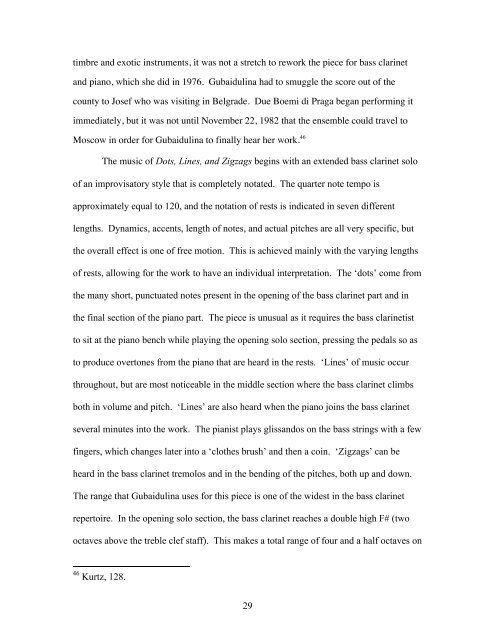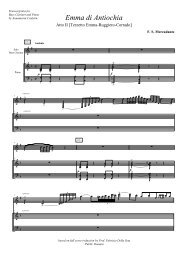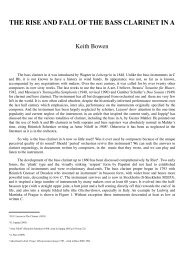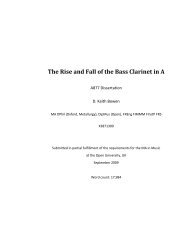Dissertation - International Bass Clarinet Research Center
Dissertation - International Bass Clarinet Research Center
Dissertation - International Bass Clarinet Research Center
You also want an ePaper? Increase the reach of your titles
YUMPU automatically turns print PDFs into web optimized ePapers that Google loves.
timbre and exotic instruments, it was not a stretch to rework the piece for bass clarinet<br />
and piano, which she did in 1976. Gubaidulina had to smuggle the score out of the<br />
county to Josef who was visiting in Belgrade. Due Boemi di Praga began performing it<br />
immediately, but it was not until November 22, 1982 that the ensemble could travel to<br />
Moscow in order for Gubaidulina to finally hear her work. 46<br />
The music of Dots, Lines, and Zigzags begins with an extended bass clarinet solo<br />
of an improvisatory style that is completely notated. The quarter note tempo is<br />
approximately equal to 120, and the notation of rests is indicated in seven different<br />
lengths. Dynamics, accents, length of notes, and actual pitches are all very specific, but<br />
the overall effect is one of free motion. This is achieved mainly with the varying lengths<br />
of rests, allowing for the work to have an individual interpretation. The ‘dots’ come from<br />
the many short, punctuated notes present in the opening of the bass clarinet part and in<br />
the final section of the piano part. The piece is unusual as it requires the bass clarinetist<br />
to sit at the piano bench while playing the opening solo section, pressing the pedals so as<br />
to produce overtones from the piano that are heard in the rests. ‘Lines’ of music occur<br />
throughout, but are most noticeable in the middle section where the bass clarinet climbs<br />
both in volume and pitch. ‘Lines’ are also heard when the piano joins the bass clarinet<br />
several minutes into the work. The pianist plays glissandos on the bass strings with a few<br />
fingers, which changes later into a ‘clothes brush’ and then a coin. ‘Zigzags’ can be<br />
heard in the bass clarinet tremolos and in the bending of the pitches, both up and down.<br />
The range that Gubaidulina uses for this piece is one of the widest in the bass clarinet<br />
repertoire. In the opening solo section, the bass clarinet reaches a double high F# (two<br />
octaves above the treble clef staff). This makes a total range of four and a half octaves on<br />
46 Kurtz, 128.<br />
29







